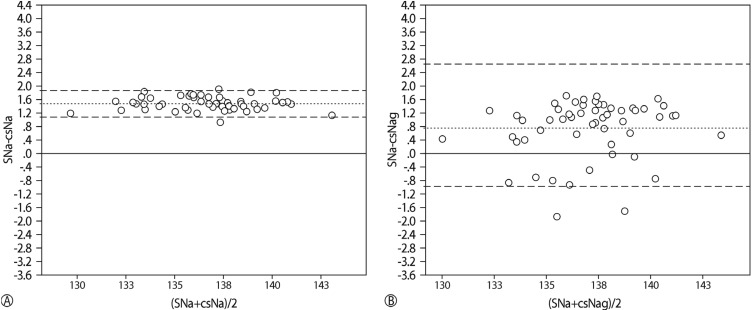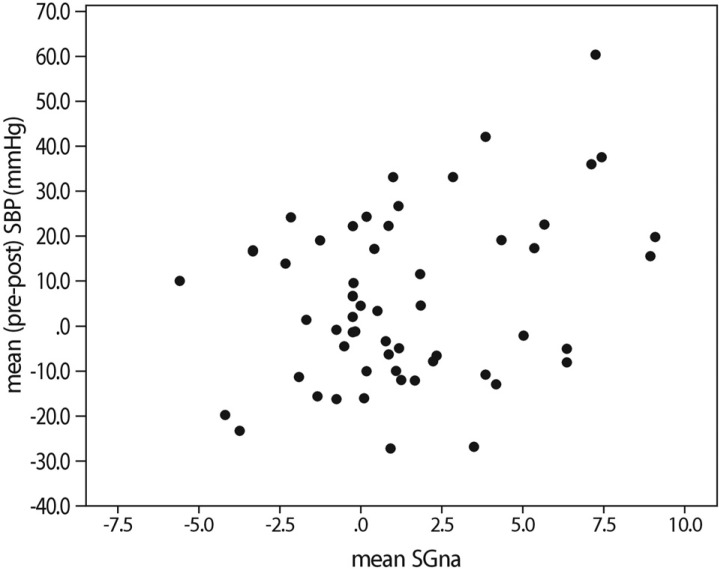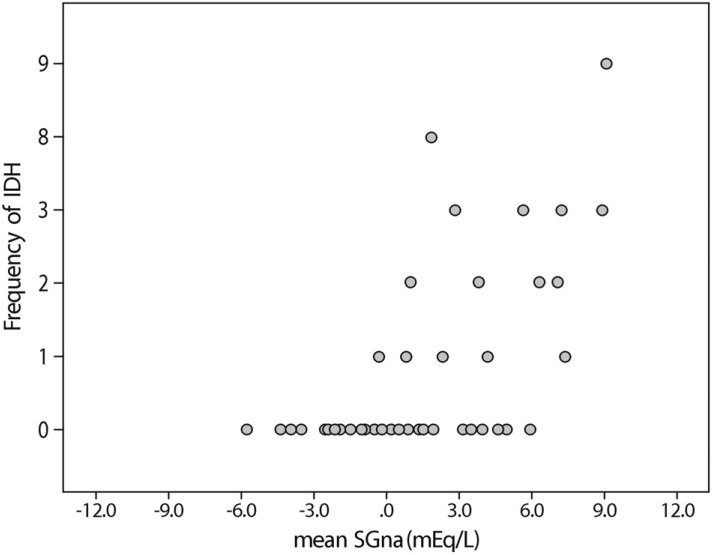Electrolyte Blood Press.
2014 Dec;12(2):66-73. 10.5049/EBP.2014.12.2.66.
Effect of Dialysate Sodium Concentration on Sodium Gradient and Hemodialysis Parameters
- Affiliations
-
- 1Division of Nephrology, Department of Internal Medicine, Yanbian University Hospital, Yanji, Jilin Province, China.
- 2Division of Nephrology and Hypertension, Department of Internal Medicine, Inha University College of Medicine, Incheon, Korea. swleemd@inha.ac.kr
- KMID: 2052333
- DOI: http://doi.org/10.5049/EBP.2014.12.2.66
Abstract
- This retrospective study was performed to determine the ranges of the sodium gradient (SG) between the dialysate sodium concentration (DNa) and serum sodium concentration (SNa) in hemodialysis (HD) patients and to examine the relationships between HD parameters over a 1 year period. Fifty-five clinically stable HD patients, who had been on HD >2 years were enrolled. Monthly HD [ultrafiltration (UF) amount, systolic blood pressure (SBP), frequency of intradialytic hypotension (IDH)] and laboratory data were collected and 12-month means were subjected to analysis. The SG was calculated by subtracting SNa from prescribed DNa. Mean SG values were 1.5+/-3.3 (range -5.6~9.1). SG was positively related to DNa and the frequency of IDH. A higher SG was associated with larger UF amounts and SBP reduction during HD. The percentages of patients with a SG > or =3mEq/L increased as DNa increased. On the other hand, SG was not found to be associated with SNa or pre-HD SBP. DNa appears to cause a significant increase in SG, and this seems to be related to HD parameters, such as, UF amount and IDH.
Keyword
MeSH Terms
Figure
Reference
-
1. Santos SFF, Peixoto AJ. Sodium balance in maintenance hemodialysis. Semin Dial. 2010; 23:549–555. PMID: 21175831.
Article2. Flanigan MJ. Sodium Flux and Dialysate Sodium in Hemodialysis. Semin Dial. 2007; 11:298–304.
Article3. Munoz Mendoza J, Sun S, Chertow GM, Moran J, Doss S, Schiller B. Dialysate sodium and sodium gradient in maintenance hemodialysis: a neglected sodium restriction approach? Nephrol Dial Transplant. 2011; 26:1281–1287. PMID: 21303968.
Article4. Hecking M, Kainz A, Hörl WH, Herkner H, Sunder-Plassmann G. Sodium setpoint and sodium gradient: influence on plasma sodium change and weight gain. Am J Nephrol. 2011; 33:39–48. PMID: 21160174.
Article5. Petitclerc T, Jacobs C. Dialysis sodium concentration: what is optimal and can it be individualized? Nephrol Dial Transplant. 1995; 10:596–599. PMID: 7566567.6. Keen ML, Gotch FA. The association of the sodium "setpoint" to interdialytic weight gain and blood pressure in hemodialysis patients. Int J Artif Organs. 2007; 30:971–979. PMID: 18067098.
Article7. Peixoto AJ, Gowda N, Parikh CR, Santos SFF. Long-term stability of serum sodium inhemodialysis patients. Blood Purif. 2010; 29:264–267. PMID: 20068291.8. Lomonte C, Basile C. Do not forget to individualize dialysate sodium prescription. Nephrol Dial Transplant. 2011; 26:1126–1128. PMID: 21372263.
Article9. Raimann JG, Thijssen S, Usvyat LA, Levin NW, Kotanko P. Sodium alignment in clinical practice-implementation and implications. Semin Dial. 2001; 24:587–592. PMID: 21999743.
Article10. Daugirdas JT. Second generation logarithmic estimates of single-pool variable volume Kt/V: an analysis of error. J Am Soc Nephrol. 1993; 4:1205–1213. PMID: 8305648.
Article11. Katz MA. Hyperglycemia-induced hyponatremia-calculation of expected serum sodium depression. N Engl J Med. 1973; 289:843–844. PMID: 4763428.12. Rasouli M, Kalantari KR. Comparison of methods for calculating serum osmolality: multivariate linear regression analysis. Clin Chem Lab Med. 2005; 43:635–640. PMID: 16006260.
Article13. Chesterton LJ, Selby NM, Burton JO, Fialova J, Chan C, McIntyre CW. Categorization of the hemodynamic response to hemodialysis: the importance of baroreflex sensitivity. HemodialInt. 2010; 14:18–28.
Article14. Hecking M, Karaboyas A, Rayner H, et al. Dialysate Sodium Prescription and Blood Pressure in Hemodialysis Patients. Am J Hypertens. 2014; 27:1160–1169. PMID: 24651636.
Article15. Levin NW, Zhu F, Keen M. Interdialytic weight gain and dry weight. Blood Purif. 2001; 19:217–221. PMID: 11150813.
Article16. Murisasco A, France G, Leblond G, et al. Sequential sodium therapy allows correction of sodium-volume balance and reduces morbidity. Clin Nephrol. 1985; 24:201–208. PMID: 4064378.17. De Paula FM, Peixoto AJ, Pinto LV, Dorigo D, Patricio PJM, Santos SFF. Clinical consequences of an individualized dialysate sodium prescription in hemodialysis patients. Kidney Int. 2004; 66:1232–1238. PMID: 15327422.
Article18. Penne EL, Thijssen S, Raimann JG, Levin NW, Kotanko P. Correction of serum sodium for glucose concentration in hemodialysis patients with poor glucose control. Diabetes Care. 2010; 33:e91. PMID: 20587711.
Article19. Penne EL, Sergeyeva O. Sodium Gradient: A Tool to Individualize Dialysate Sodium Prescription in Chronic Hemodialysis Patients? Blood Purif. 2011; 31:86–91. PMID: 21228573.
Article20. Marshall MR, Dunlop JL. Are dialysate sodium levels too high? Semin Dial. 2012; 25:277–283. PMID: 22487090.
Article21. Gembala M, Kumar S. Carpi A, editor. Sodium and Hemodialysis. In: Progress in Hemodialysis - From Emer- gent Biotechnology to Clinical Practice [Internet]. InTech;2011. cited 2014 Jun 8. Available from: http://www.intechopen.com/books/progress-in-hemodialysis-from-emergent-biotechnology-to-clinical-practice/sodium-and-hemodialysis.22. Parker T 3rd. Creating an open dialogue on improving dialysis care. Nephrol News Issues. 2013; 27:14–16. PMID: 24266267.23. Kim SM, Kim JG, Shin JH, et al. The effects of low sodium dialysate in hemodialysis patients. Korean J Nephrol. 2011; 30:53–60.24. Hecking M, Karaboyas A, Saran R, et al. Predialysis serum sodium level, dialysate sodium, and mortality in maintenance hemodialysis patients: the Dialysis Outcomes and Practice Patterns Study (DOPPS). Am J Kidney Dis. 2012; 59:238–248. PMID: 21944663.
Article25. Hecking M, Karaboyas A, Saran R, et al. Dialysate sodium concentration and the association with interdialytic weight gain, hospitalization, and mortality. Clin J Am SocNephrol. 2012; 7:92–100.
Article26. Mc Causland FR, Brunelli SM, Waikar SS. Dialysate sodium, serum sodium and mortality in maintenance hemodialysis. Nephrol Dial Transplant. 2012; 27:1613–1618. PMID: 21891777.
Article27. Gotch FA, Lam MA, Prowitt M, Keen M. Preliminary clinical results with sodium-volume modeling of hemodialysis therapy. Proc Clin Dial Transplant Forum. 1980; 10:12–17. PMID: 7346841.
- Full Text Links
- Actions
-
Cited
- CITED
-
- Close
- Share
- Similar articles
-
- Sodium Balance in Maintenance Hemodialysis
- The Effect of Gradient Ultrafiltration and High Sodium Dialysate on Reducing Complications During Hemodialysis
- The Effect of Cool Dialysate & Sodium Profiling on Hemodynamics in Patients with Intradialytic Hypotension
- Effect of Individual Low Sodium Dialysate on Blood Pressure, Interdialytic Weight Gain, Thirst and Intradialytic Discomfort In End-Stage Renal Disease Patients
- The Effects of Low Sodium Dialysate in Hemodialysis Patients







